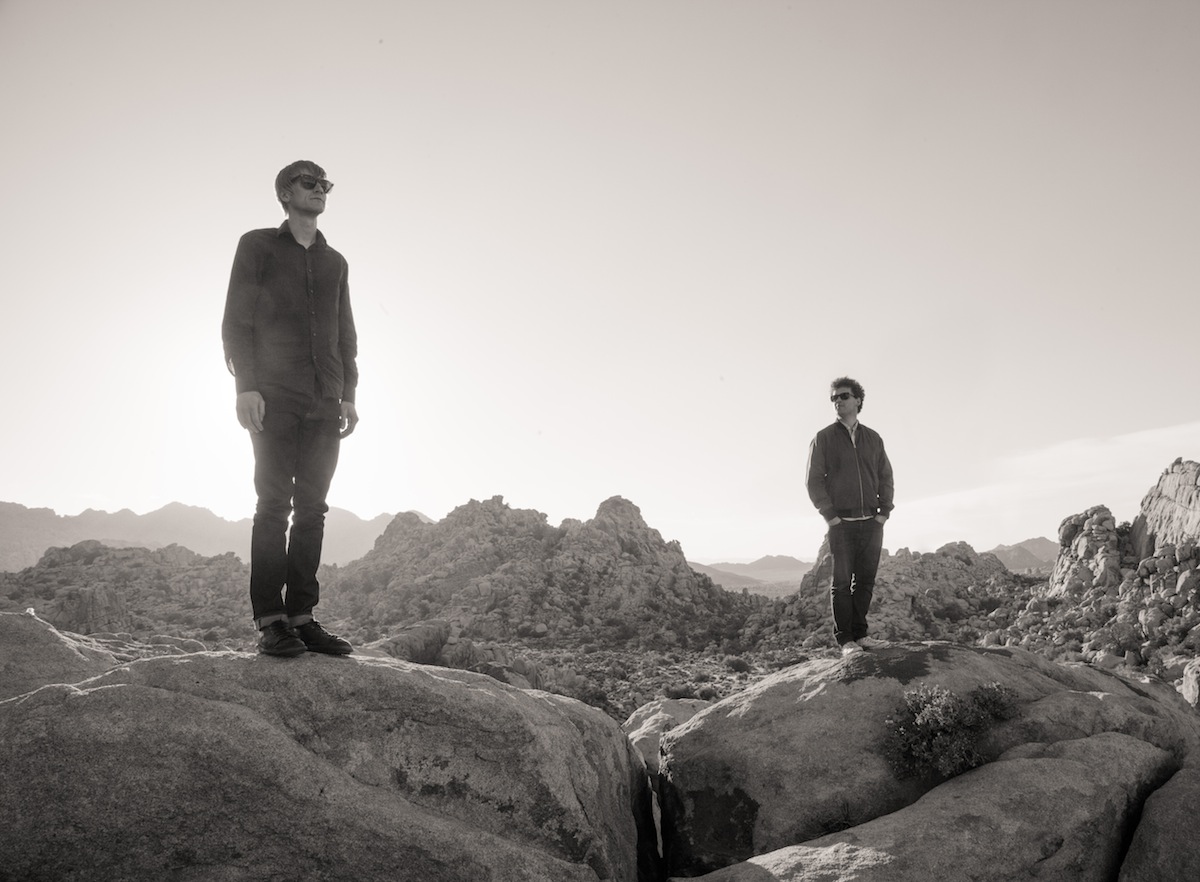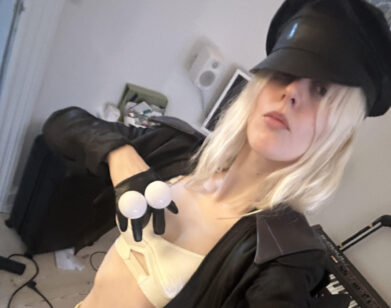Simian Mobile Disco’s Brand-New Whorl

ABOVE: SIMIAN MOBILE DISCO’S JAS SHAW (LEFT) AND JAMES FORD
In the realm of electronic music, the men behind Simian Mobile Disco are no strangers to faring well in unknown ventures. The London-based pair shed their traditional rock-band persona, Simian, in 2005 and dove headfirst into the pull of exploratory house and electronic dance music. A countless body of remixes, residencies, albums, and their own imprint (Delicacies) later, members Jas Shaw and James Ford, who played keyboards and drums, respectively, in Simian, have turned excavating experimental sounds from temperamental synthesizers into a high art form. Since the 2007 release of their first album Attack Decay Sustain Release, the duo has established a name playing music on analog equipment, swimming against the tide in electronic music as it gravitated increasingly towards digital.
When the opportunity to record a live album in a honkytonk bar near Joshua Tree, California came across their way, the two naturally snatched it up. The resulting album, Whorl, recorded at a Pappy and Harriets in April of this year, sounds as if it emerged from a galactic ether, an otherworldly aural landscape that incorporates as much desert as it does space. Interview caught up with one-half of the band on the eve of Whorl’s release to discuss the project. Read on for our interview below.
JOY SHI: Where are you calling from right now?
JAS SHAW: I’m at home now. I was at Green Man, it’s a festival out in Wales that does weird electronic stuff and kind of weird, folk-y music.
SHI: Was recording Whorl your first time out in that area, or had you been to Joshua Tree before?
SHAW: We’d both been out to that sort of vague area a bunch of times for, what’s that festival that was close by…
SHI: Coachella?
SHAW: Coachella [laughs]. That was the one. Even though Coachella is technically out in the desert bit, you don’t really see it that way. It might as well be a city—its own city, to be fair. But still, it doesn’t feel wild. And so it was very new for me; I’d never really spent any time in the desert, and that was part of the appeal of it. James had been before and really liked it, and I just really liked the idea of going out in the desert rather than being in the studio here in London.
SHI: How did the idea for recording a live album come about, did it come hand in hand with recording in Joshua Tree?
SHAW: We were toying around with lots of different places. The idea of recording not in the studio came from the live show and how cool things happened in the live show that are difficult to replicate in the studio. We also wanted to remove, or rather limit, our own ability to clean everything up. I think having a solid take makes you less likely to go back. But as soon as the option came up to record in the desert, it was so obvious. It’s a holiday, and it was kind of a step into the unknown as well, which was something we really wanted it to be.
SHI: What was the impulse for this challenge?
SHAW: One of the things that I’ve always slightly struggled with in electronic music is the perfection in it. It’s very easy to make things very smooth and perfect. Historically, electronic music has been pretty rough; the early musique concrète stuff, it’s really coarsely thrown together. With acid house, it’s not that it’s so lo-fi, it’s that it’s doing the best with quite a limited amount. Just as sequences and software have gotten better and better, they hold your hand to a certain extent. The danger is that what comes out is made more bland by this fact. There’s something that you have with the band when they know the red light is on… that pressure, you can’t trick yourself into it. If we were doing the same thing in the studio, we couldn’t be like, “Okay, now imagine there’s several hundred people in the desert in a biker bar.” Of course, there were lots of problems doing it that way, like stuff drifting and compromises we had to make in order to record out there, but I feel like what we gained in spirit of it is worth it.
SHI: What were your and James’s rehearsals for this like? Did you have a general idea for each song?
SHAW: Before we went out to the desert, all the patterns were written and we’d played it all the way through. Every time we play it, it comes out pretty different. We can usually play it similar-ish. It would be disingenuous to say we magic-hatted it right out that night, but the way it manifests every night is really dependent on the synths and also the environment and the people who are there, and what time you’re playing. All stuff that feeds into the decisions that you make.
SHI: Have you ever considered a completely improvised live show?
SHAW: We have. But you need a really patient crowd for that; sometimes it’s a good 15 minutes of faffing about until you get something good. Unless it’s improvisation in the blues sense of the word, where you have a scale you can razz up and down and you can’t really go wrong. In this case, we knew we wanted things to be written in terms of all the melodies and a loose structure. How we run the live show, there’s a few flag points you have to go to.
SHI: It’s kind of like you and James had a map for on a treasure hunt, and knew which places to search out.
SHAW: That’s a good description. The flag points are something to aim for, and there are so many different ways to get to them. Also with the gear that we’re using—it’s so cranky, it really pulls out random things each night. At the start, it used to stress me out a lot more when a touring modular would flip out during one song and I’d spend the rest of the song trying to get it back in line. But after having done it so many times, I’m pretty comfortable with having the synths go west; it’s kind of why we bring them out with us. If we wanted it to sound the same every time we’d just use plug-ins.
SHI: What mindset were you in when you were conceptualizing the tracks?
SHAW: We knew from the outset we wanted it to be cinematic and drone-y and obviously pretty synth-y. The synthesizers themselves really define the range of sounds. The main image we had in our heads all the way through writing was the desert, which was amazing because it was not something we considered in terms of being such an influence. We were in London, it was winter. It was drone-y and drizzly. And I’d been imagining the Gobi desert, a little Easy Rider.
SHI: Did you Google an image of Pappy and Harriets to visualize it?
SHAW: I looked it up. There’s definitely a mood that was a great starting point. It was kind of the Socratic idea of a western; the average of every one I’d seen. Cowboy boots, clinking horses, beers, brawls all that nonsense. But once you get into recording a record, there just isn’t time to be dipping into other references, especially as we were really up against it time-wise. We had a gig abroad to have it ready for, so it really was an absolute deadline.
SHI: Listening to the album and being at the experience itself, it’s hard not to feel like as much as it was inspired by the desert, it was also inspired by the amplified presence of space.
SHAW: Space was definitely a reference. We did loads of scampering around in the desert being idiots, and one of the things that was really nice out there was this app, Starmap, which is pretty much useless in major cities. It was amazing. I guess it’s kind of a classic psychedelia thing; looking up at space and feeling small and wondering about the world. One of the things about doing it in the middle of nowhere was that for the people who came, it turned out to be an adventure as well. People who came weren’t just casual fans; it was a three- or four-hour drive into the desert, people had to want to come. Most of the people who came out did it with a bunch of friends and it was a real feat. They were people who we wanted to be at the recording. It was nice to have created something like that.
SHI: What influenced the naming of the album?
SHAW: Ordinarily we’re batting around the name until we’re waiting for the album cover to finish. With this, they needed a title before we’d even started writing anything. Part of “whorl” had to do with nature: a cycle on your fingerprint, a point on a plant where the branches diverge. But more broadly it’s a nested sequence of circular patterns. We knew it was going to be based on these really simple looping sequences, usually less than 16 steps, that loop around and around to create something more complicated.
SHI: How has taking Whorl out on the road again been?
SHAW: It is a beast to tour, simply because there’s no backup for any of it. There’s two modular synths, and we’ve already had three die on us. It’s not unusual, and we were lucky which ones died, because we were able to patch around things. But it is a constant fix-it job to tour.
SHI: Has Simian Mobile Disco changed for you and James over time?
SHAW: I think it has. When we started out with no intention of releasing any music, we were in a shared room making music for fun. That side of it hasn’t changed at all. Once we got going, I think our music tastes have changed. When we started we’d just come out of being a weird indie band, so our references into dance music were much more electronica than straight-up dance music; we weren’t well-versed at the time. We knew the very old electronic pioneers side of it but we didn’t know our bones in house or techno. And I think in the process of DJing a lot, we got deeper and deeper into techno and house, I call it “proper club music.” I guess SMD changed with it. We are willing to play more dub-techno-bonkers than crossover festivals. Because that’s where I want to go when I go out. I don’t want to see bands I can hear on the radio; I want to see interesting, weird techno acts.
SIMIAN MOBILE DISCO’S WHORL IS OUT NOW. FOR MORE ON THE BAND, PLEASE VISIT ITS WEBSITE.






